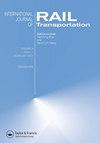Probabilistic machine learning approach to reliability analysis of a bogie frame under dynamic loading
IF 3.6
2区 工程技术
Q2 TRANSPORTATION SCIENCE & TECHNOLOGY
International Journal of Rail Transportation
Pub Date : 2023-11-03
DOI:10.1080/23248378.2023.2274369
引用次数: 0
Abstract
ABSTRACTThis study aims to evaluate the fatigue failure probability of a bogie frame considering the variability of input parameters, including loading (L), endurance limit (Se), and fillet size (r), through a data-driven surrogate model. Mechanical tests were conducted to determine the mechanical properties of the material of the bogie frame while a combination of machine learning and FEA has been utilized to generate a dataset for the dynamic response of the bogie frame under main in-service fatigue loads. Nine machine learning-based surrogate models were constructed based on the actual response at a limited set of data points chosen by the Optimum space-filling algorithm, and their accuracy was investigated. It is found that the CatBoost model is the optimal algorithm to map the stochastic input parameters with the factor of safety as the output parameter and perform the reliability evaluation. Also, results reveal a fatigue reliability of 99.34% for the bogie frame under normal conditions, with a cumulative failure probability of less than 0.66% over a 30-year service life. Furthermore, the results show that the proposed machine learning-based approach is an efficient tool to evaluate the fatigue failure probability of the bogie frame with reasonable accuracy when a small set of training data is available. This study’s scope extends to providing comprehensive guidelines for employing machine learning methods for fatigue reliability analysis of complex vehicle structures in the presence of various stochastic variables.KEYWORDS: Bogie framefatigue failure probabilitystructural reliabilitymachine learningsurrogate modelFEM Disclosure statementNo potential conflict of interest was reported by the authors.Author contributionsSeyed Ahmad Sanikhani: Investigation, Methodology, Software, Visualization, Formal Analysis, Writing – Reviewing and Editing. Mehdi Soroush: Conceptualization, Validation, Software, Visualization, Formal Analysis, Writing – Original Draft Preparation, Writing – Reviewing and Editing. Kourosh Alizadeh Kiani: Data Curation, Formal Analysis, Software, Visualization, Writing – Reviewing and Editing. Mohammad Ravandi: Supervision, Writing – Reviewing and Editing. Mohsen Rezaeian Akbarzadeh: Supervision.Additional informationFundingThe authors received no financial support for this article’s research, authorship, and publication.基于概率机器学习的转向架动载可靠性分析
摘要本研究旨在通过数据驱动的替代模型,在考虑载荷(L)、耐力极限(Se)和圆角尺寸(r)等输入参数变化的情况下,评估转向架车架的疲劳失效概率。通过力学试验确定了转向架框架材料的力学性能,同时利用机器学习和有限元分析相结合的方法生成了转向架框架在主要在役疲劳载荷下的动态响应数据集。基于最优填充算法在有限数据点上的实际响应,构建了9个基于机器学习的代理模型,并对其准确性进行了研究。结果表明,CatBoost模型是将随机输入参数映射为安全系数作为输出参数进行可靠性评估的最优算法。此外,结果表明,在正常条件下,转向架框架的疲劳可靠性为99.34%,在30年的使用寿命中,累积失效概率小于0.66%。此外,研究结果表明,在训练数据较少的情况下,基于机器学习的方法是评估转向架框架疲劳失效概率的有效工具,且具有合理的精度。本研究的范围扩展到在各种随机变量存在的情况下,为使用机器学习方法进行复杂车辆结构的疲劳可靠性分析提供全面的指导方针。关键词:转向架框架疲劳失效概率结构可靠性机器学习替代模型有限元披露声明作者未报告潜在利益冲突。赛义德·艾哈迈德·萨尼哈尼:调查,方法论,软件,可视化,形式分析,写作-审查和编辑。Mehdi Soroush:概念化,验证,软件,可视化,形式分析,写作-原始草稿准备,写作-审查和编辑。Kourosh Alizadeh Kiani:数据管理,形式分析,软件,可视化,写作-审查和编辑。Mohammad Ravandi:监督,写作-审查和编辑。Mohsen rezaian Akbarzadeh:监督。本文作者在研究、创作和出版过程中未获得任何资金支持。
本文章由计算机程序翻译,如有差异,请以英文原文为准。
求助全文
约1分钟内获得全文
求助全文
来源期刊

International Journal of Rail Transportation
TRANSPORTATION SCIENCE & TECHNOLOGY-
CiteScore
6.90
自引率
15.00%
发文量
51
期刊介绍:
The unprecedented modernization and expansion of rail transportation system will require substantial new efforts in scientific research for field-deployable technologies. The International Journal of Rail Transportation (IJRT) aims to provide an open forum for scientists, researchers, and engineers in the world to promote the exchange of the latest scientific and technological innovations in rail transportation; and to advance the state-of-the-art engineering and practices for various types of rail based transportation systems. IJRT covers all main areas of rail vehicle, infrastructure, traction power, operation, communication, and environment. The journal publishes original, significant articles on topics in dynamics and mechanics of rail vehicle, track, and bridge system; planning and design, construction, operation, inspection, and maintenance of rail infrastructure; train operation, control, scheduling and management; rail electrification; signalling and communication; and environmental impacts such as vibration and noise. The editorial policy of the new journal will abide by the highest level of standards in research rigor, ethics, and academic freedom. All published articles in IJRT have undergone rigorous peer review, based on initial editor screening and anonymous refereeing by independent experts. There are no page charges and colour figures are included in the online edition free of charge.
 求助内容:
求助内容: 应助结果提醒方式:
应助结果提醒方式:


